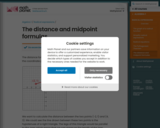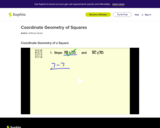
Distance and midpoint formulas are explained through the use of examples and a video lesson. [1:58]
- Subject:
- Mathematics
- Material Type:
- Lesson
- Provider:
- Mathplanet
- Provider Set:
- Algebra 1
- Date Added:
- 10/01/2022

Distance and midpoint formulas are explained through the use of examples and a video lesson. [1:58]

This lesson [8:14] will demonstrate how to use slope, midpoint, and distance formulas to determine from the coordinates of the vertices if a quadrilateral is an isosceles trapezoid in a coordinate plane. It is 2 of 5 in the series titled "Coordinate Geometry of Isosceles Trapezoids."

This lesson will demonstrate how to use slope, midpoint, and distance formulas to determine from the coordinates of the vertices if a quadrilateral is a parallelogram in a coordinate plane. Students can check their understanding with an assessment. [12:13]

This lesson [7:43] will demonstrate how to use slope, midpoint, and distance formulas to determine from the coordinates of the vertices if a quadrilateral is a parallelogram in a coordinate plane. It is 3 of 6 in the series titled "Coordinate Geometry of Parallelograms."

This lesson [8:39] will demonstrate how to use slope, midpoint, and distance formulas to determine from the coordinates of the vertices if a quadrilateral is a rectangle in a coordinate plane. It is 1 of 5 in the series titled "Coordinate Geometry of Rectangles."

This lesson [8:08] will demonstrate how to use slope, midpoint, and distance formulas to determine from the coordinates of the vertices if a quadrilateral is a rhombus in a coordinate plane. It is 1 of 4 in the series titled "Coordinate Geometry of Rhombii."

This lesson [8:20] will demonstrate how to use slope, midpoint, and distance formulas to determine from the coordinates of the vertices if a quadrilateral is a rhombus in a coordinate plane. It is 2 of 4 in the series titled "Coordinate Geometry of Rhombii."

This lesson will demonstrate how to use slope, midpoint, and distance formulas to determine from the coordinates of the vertices if a quadrilateral is a rhombus in a coordinate plane. It is 3 of 4 in the series titled "Coordinate Geometry of Rhombii." [16:32]

This lesson will demonstrate how to use slope, midpoint, and distance formulas to determine from the coordinates of the vertices if a quadrilateral is a square in a coordinate plane. It is 3 of 3 in the series titled "Coordinate Geometry of Square." [16:21]

This lesson [8:34] will demonstrate how to use slope, midpoint, and distance formulas to determine, from the coordinates of the vertices, if a quadrilateral is a square in a coordinate plane. It is 1 of 2 in the series titled "Coordinate Geometry of Squares."

This lesson [5:14] will demonstrate how to use slope, midpoint, and distance formulas to determine, from the coordinates of the vertices, if a quadrilateral is a trapezoid in a coordinate plane. It is 1 of 4 in the series titled "Coordinate Geometry of Trapezoids."

This lesson [7:20] will demonstrate how to use slope, midpoint, and distance formulas to determine, from the coordinates of the vertices, if a quadrilateral is a trapezoid in a coordinate plane. It is 2 of 4 in the series titled "Coordinate Geometry of Trapezoids."

This lesson [15:33] will demonstrate how to use slope, midpoint, and distance formulas to determine, from the coordinates of the vertices of a quadrilateral, if the shape is a trapezoid. It is 4 of 4 in the series titled "Coordinate Geometry of Trapezoids."

Principles of Macroeconomics 2e covers the scope and sequence of most introductory economics courses. The text includes many current examples, which are handled in a politically equitable way. The outcome is a balanced approach to the theory and application of economics concepts. The second edition has been thoroughly revised to increase clarity, update data and current event impacts, and incorporate the feedback from many reviewers and adopters. Changes made in Principles of Macroeconomics 2e are described in the preface and the transition guide to help instructors transition to the second edition. The first edition of Principles of Macroeconomics by OpenStax is available in web view here.


By the end of this section, you will be able to:
Calculate the price elasticity of demand
Calculate the price elasticity of supply

This lesson from Purplemath demonstrates how to use the Midpoint Formula and shows typical problems using the Midpoint Formula.

A written proof that shows how the midpoint formula works.

Find a quick, concise explanation of the midpoint formula. An example is given and clearly explained for the midpoint formula in one, two, and three dimensions.